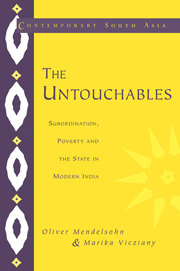Book contents
- Frontmatter
- Contents
- List of tables
- Glossary
- Preface
- 1 Who are the Untouchables?
- 2 The question of the ‘Harijan atrocity’
- 3 Religion, politics and the Untouchables from the nineteenth century to 1956
- 4 Public policy I: adverse discrimination and compensatory discrimination
- 5 Public policy II: the anti-poverty programs
- 6 The new Untouchable proletariat: a case study of the Faridabad stone quarries
- 7 Untouchable politics and Untouchable politicians since 1956
- 8 The question of reservation: the lives and careers of some Scheduled Caste MPs and MLAs
- 9 Subordination, poverty and the state in modern India
- Bibliography
- Index
Preface
Published online by Cambridge University Press: 05 June 2012
- Frontmatter
- Contents
- List of tables
- Glossary
- Preface
- 1 Who are the Untouchables?
- 2 The question of the ‘Harijan atrocity’
- 3 Religion, politics and the Untouchables from the nineteenth century to 1956
- 4 Public policy I: adverse discrimination and compensatory discrimination
- 5 Public policy II: the anti-poverty programs
- 6 The new Untouchable proletariat: a case study of the Faridabad stone quarries
- 7 Untouchable politics and Untouchable politicians since 1956
- 8 The question of reservation: the lives and careers of some Scheduled Caste MPs and MLAs
- 9 Subordination, poverty and the state in modern India
- Bibliography
- Index
Summary
Our primary debt in the preparation of this work is to the people who form its subject. We have talked to many hundreds of them over the years, and they have been marvellously trusting and generous with their time. Only one of them ever complained – we had tried his patience that day, and he wanted to get on with his work. His name is Amee Chand, a Bhangi (Valmiki) tailor in Alwar District of Rajasthan, and over many years he has been simply our very best source of knowledge. We hope that this book is sufficient justification for the trouble to which we put Amee Chand and so many others.
We cannot hope to thank all the people in official, academic and journalism circles who have given us assistance. Indeed, many of the officials must not be named for fear of embarrassing them. But the following are some of the people who were invaluable in gathering the material for this book. Swami Agnivesh has become a friend as well as a person whom we have written about, and his assistance has been crucial. Inder Mohan also helped us in understanding the situation of the new urban poor such as the rag pickers and the quarry workers. Bhagwan Das provided some early insight into the Ambedkarite movement, and L. G. Havanur gave us a copy of his influential report (and a memorable lunch in Bangalore). Raghavan, then of The Times of India, Jakapanavar, Indudan Honnapur and Professor Parvathamma were also specially useful in Bangalore and Mysore.
- Type
- Chapter
- Information
- The UntouchablesSubordination, Poverty and the State in Modern India, pp. xvii - xviiiPublisher: Cambridge University PressPrint publication year: 1998

